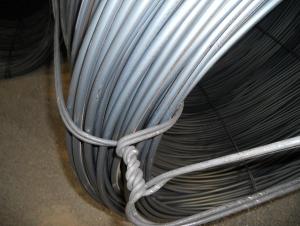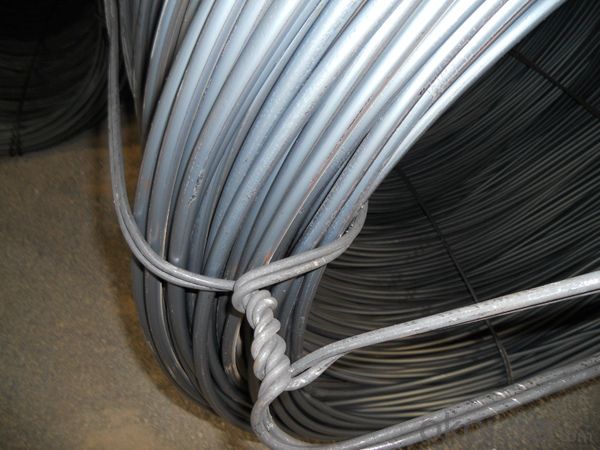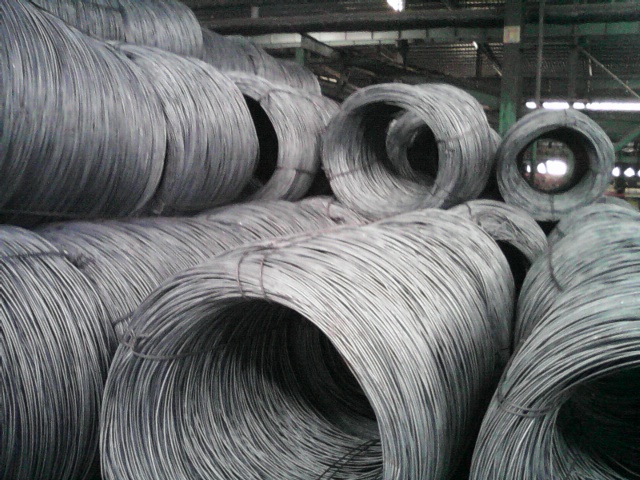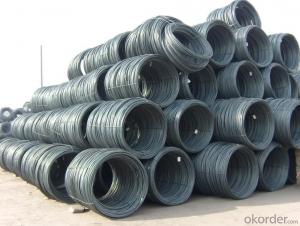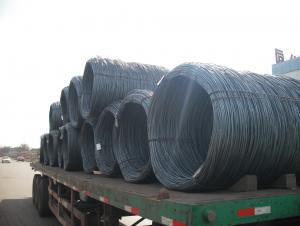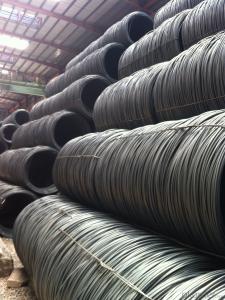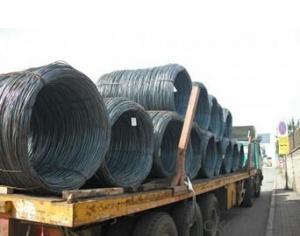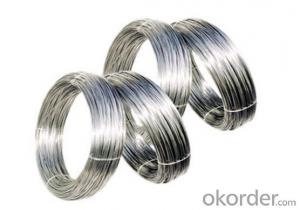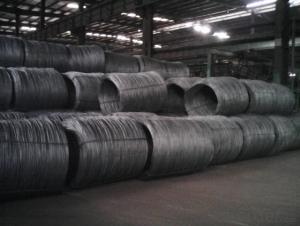Hot Rolled Low Carbon Steel Wire Rods for Nails, Steel Wire Mesh
- Loading Port:
- Tianjin
- Payment Terms:
- TT or LC
- Min Order Qty:
- 25 m.t.
- Supply Capability:
- 100000 m.t./month
OKorder Service Pledge
OKorder Financial Service
You Might Also Like
Product Description:
OKorder is offering Hot Rolled Low Carbon Steel Wire Rods for Nails, Steel Wire Mesh at great prices with worldwide shipping. Our supplier is a world-class manufacturer of steel, with our products utilized the world over. OKorder annually supplies products to African, South American and Asian markets. We provide quotations within 24 hours of receiving an inquiry and guarantee competitive prices.
Product Applications:
Hot Rolled Low Carbon Steel Wire Rods for Nails, Steel Wire Mesh are ideal for structural applications and are widely used in construction and manufacturing. Carbon steel wire rod is mainly used for reinforcement of reinforced concrete and welded structure or reprocessed (roberts , nail, etc.) materials, especially used to produce wire drawing, welding electrode, nails, spring, electronic, precise machinery parts and so on.
Product Advantages:
OKorder's Hot Rolled Low Carbon Steel Wire Rods for Nails, Steel Wire Mesh are durable, strong, and wide variety of sizes. They are newly produced by good quality steel billets.
Main Product Features:
· Premium quality
· Prompt delivery & seaworthy packing (30 days after receiving deposit)
· Can be recycled and reused
· Mill test certification
· Professional Service
· Competitive pricing
Product Specifications:
Steel Grade: SAE1006-1018B
Standard: ASTM, GB
Diameter: 5.5mm, 6.5mm, 7mm,8mm,9mm,10mm,12mm,14mm
Type: in coil, coil weight around 2MT
Alloy or Not: Alloy
Technique: Hot Rolled
Place of Origin: China Mainland
Surface: round, no twisted, light and smooth
FAQ:
Q1: Why buy Hot Rolled Low Carbon Steel Wire Rods for Nails, Steel Wire Mesh from OKorder.com?
A1: All products offered byOKorder.com are carefully selected from China's most reliable manufacturing enterprises. Through its ISO certifications, OKorder.com adheres to the highest standards and a commitment to supply chain safety and customer satisfaction.
Q2: How do we guarantee the quality of our products?
A2: We have established an advanced quality management system which conducts strict quality tests at every step, from raw materials to the final product. At the same time, we provide extensive follow-up service assurances as required.
Q3: How soon can we receive the product after purchase?
A3: Within three days of placing an order, we will arrange production. The normal sizes with the normal grade can be produced within one month. The specific shipping date is dependent upon international and government factors, the delivery to international main port about 45-60days.
Images:
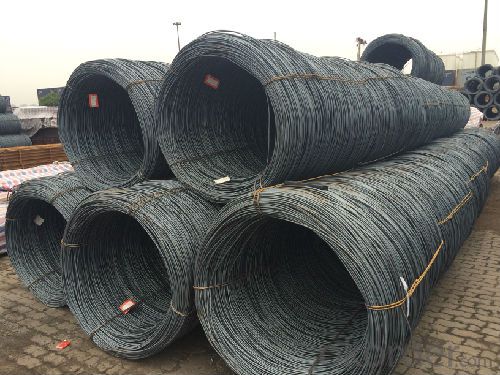

- Q: What are the common applications of high-strength and oil tempered steel wire rod?
- High-strength and oil tempered steel wire rod has a wide range of applications due to its unique properties. Some of the common applications include: 1. Automotive industry: High-strength steel wire rod is used in various automotive components such as suspension springs, engine valve springs, clutch springs, and seat springs. Its high tensile strength and excellent fatigue resistance make it suitable for these demanding applications. 2. Construction industry: Steel wire rod is used in construction applications such as pre-stressed concrete structures, post-tensioning systems, and reinforcement for concrete structures. Its high strength helps in providing structural stability and durability. 3. Manufacturing industry: Steel wire rod is used in the manufacturing of various products like wire ropes, cables, springs, and fasteners. Its high strength and elasticity make it ideal for these applications where flexibility and durability are required. 4. Electrical industry: Steel wire rod is used in the manufacturing of electrical conductors, such as overhead power lines and electrical cables. Its high conductivity and strength enable efficient transmission of electricity over long distances. 5. Agriculture industry: Steel wire rod is used in the manufacturing of fencing materials, barbed wires, and support structures for crops. Its strength and durability help in providing effective protection and support to agricultural fields. 6. Furniture industry: Steel wire rod is used in the manufacturing of furniture items like springs for mattresses and seating arrangements. Its ability to withstand heavy loads and provide comfort makes it a popular choice in the furniture industry. Overall, high-strength and oil tempered steel wire rod find extensive applications in various industries due to their exceptional strength, durability, and flexibility.
- Q: What are the typical chemical compositions of steel wire rod?
- The typical chemical compositions of steel wire rod vary depending on the specific grade and desired properties. However, commonly used compositions include carbon (0.06-0.25%), manganese (0.30-1.00%), silicon (0.10-0.30%), sulfur (0.05% max), and phosphorus (0.04% max). Other elements like chromium, nickel, and copper may also be present in smaller amounts to enhance certain properties.
- Q: How is steel wire rod packaged for transportation and storage?
- Steel wire rod is typically packaged in a manner that guarantees its protection and ease of handling during transportation and storage. To achieve this, a series of steps are taken to ensure the product's safety and integrity. Typically, steel wire rod is bundled together using steel straps or wires. These bundles are tightly secured to prevent any movement or damage while being transported. The size and weight of these bundles may vary depending on the specific requirements and dimensions of the wire rods. To offer further protection against external factors like moisture, dust, and corrosion, it is common to coat the wire rod with a layer of oil or other rust-resistant material. This coating helps maintain the wire rod's quality and durability while in storage or during transportation. The bundles of steel wire rod are then stacked and stored in a warehouse or on a pallet. This method ensures easy handling and efficient use of space. The pallets, made from wood, plastic, or metal, are designed to withstand the weight and pressure of the wire rod bundles. Additionally, they facilitate the use of forklifts or other lifting equipment for loading and unloading purposes. During transportation, steel wire rod is typically loaded onto trucks, trains, or ships for long-distance travel. Proper lifting equipment is employed during the loading and unloading process to ensure the bundles' safety and integrity. The wire rod bundles are securely fastened and secured to prevent any movement that could potentially cause damage. In summary, the packaging of steel wire rod for transportation and storage involves securely bundling, applying a protective coating, stacking and storing on pallets, and using appropriate lifting equipment. These measures are essential in guaranteeing the wire rod's safety, quality, and integrity throughout its journey from the manufacturing facility to its final destination.
- Q: How is steel wire rod bundled and packaged for transportation?
- Steel wire rods are bundled and packaged for transportation to ensure their safety and ease of handling. There are several methods commonly used for bundling and packaging steel wire rods. One common method is to bundle the rods together using steel straps or wires. The rods are typically arranged in a neat stack, and the straps or wires are tightly wrapped around the bundle to hold the rods securely in place. This bundling method helps to prevent the rods from shifting or rolling during transportation, reducing the risk of damage. In addition to bundling, steel wire rods are often packaged in wooden crates or pallets for added protection. These crates or pallets provide a sturdy and stable base for the bundled rods, making it easier to lift and move them using forklifts or other handling equipment. The crates or pallets also shield the rods from direct contact with the ground, minimizing the risk of corrosion or other damage. To further protect steel wire rods during transportation, they may be wrapped in plastic or shrink-wrap. This additional layer of packaging helps to shield the rods from moisture, dust, and other contaminants that could potentially cause corrosion or surface damage. Labels and markings are also applied to the bundles and packaging to provide important information about the contents, such as the type and grade of steel, the quantity of rods, and any specific handling instructions. These labels and markings assist in the efficient and accurate identification and handling of the steel wire rods during transportation and storage. Overall, bundling and packaging steel wire rods for transportation involves securing the rods together using steel straps or wires, placing them in wooden crates or pallets, and adding additional protection through plastic or shrink-wrap. This ensures that the rods are well-protected, organized, and easily handled throughout the transportation process.
- Q: Can steel wire rod be used for welding applications?
- Yes, steel wire rod can be used for welding applications. It is commonly used as a filler material in welding processes such as MIG (Metal Inert Gas) welding and TIG (Tungsten Inert Gas) welding. The steel wire rod provides a stable and consistent filler material, ensuring strong and reliable welds.
- Q: What are the major trade associations and organizations in the steel wire rod industry?
- Some major trade associations and organizations in the steel wire rod industry include the American Iron and Steel Institute (AISI), the Steel Manufacturers Association (SMA), and the International Wire and Machinery Association (IWMA). These organizations play a significant role in promoting the steel wire rod industry, advocating for its interests, and facilitating collaboration among industry stakeholders.
- Q: How is steel wire rod tested for resistance to intergranular corrosion?
- Steel wire rod is tested for resistance to intergranular corrosion through a process called the Strauss test, also known as the ASTM A262 test. This involves subjecting the steel wire rod to a specific corrosive solution, such as a boiling nitric acid mixture. The wire rod is then visually inspected for signs of intergranular corrosion, such as cracking or disintegration. Additionally, metallographic examination may be conducted to analyze the microstructure of the wire rod and determine the extent of intergranular corrosion.
- Q: How are surface defects in steel wire rod classified?
- Surface defects in steel wire rod are classified based on their characteristics and appearance. Some common classifications of surface defects in steel wire rod include: 1. Scale: Scale defects occur when the steel wire rod is exposed to high temperatures during the manufacturing process and forms a layer of oxide on its surface. Scale defects may appear as a rough, flaky, or scaly surface and can negatively affect the wire's performance. 2. Pits: Pits are small depressions or cavities on the surface of the steel wire rod. They can be caused by various factors such as corrosion, improper handling, or manufacturing defects. Pits can weaken the wire's structural integrity and compromise its functionality. 3. Scratches: Scratches are superficial marks or grooves on the surface of the steel wire rod. They can occur during handling, transportation, or manufacturing processes. Although scratches may not significantly impact the wire's strength, they can affect its appearance and may lead to further corrosion if left untreated. 4. Cracks: Cracks are linear fractures that extend through the surface of the steel wire rod. They can be caused by improper cooling, excessive stress, or manufacturing defects. Cracks are considered severe defects as they can propagate and lead to catastrophic failure under load. 5. Inclusions: Inclusions are non-metallic particles or impurities embedded within the steel wire rod's surface. These can include slag, oxides, or foreign materials introduced during the manufacturing process. Inclusions weaken the wire's mechanical properties and can contribute to premature failure. 6. Decarburization: Decarburization is a process where the carbon content at the surface of the steel wire rod is reduced. It can occur due to improper heat treatment or exposure to high temperatures. Decarburization weakens the wire's hardness and can negatively impact its performance. 7. Lamination: Laminations are layers or separations within the steel wire rod that occur during the rolling process. They can be caused by inadequate bonding between layers or impurities within the steel. Laminations can weaken the wire's structure and compromise its mechanical properties. Classifying surface defects in steel wire rod is crucial for quality control and ensuring the wire's reliability and performance. By identifying and categorizing these defects, manufacturers can take appropriate measures to minimize their occurrence and improve the overall quality of the wire rod.
- Q: What are the main factors affecting the market diversification of steel wire rod?
- The main factors affecting the market diversification of steel wire rod include fluctuations in global demand for steel products, changes in market dynamics and trends, advancements in technology and production processes, regulatory and trade policies, competition from alternative materials, and consumer preferences and requirements.
- Q: How does the dimensional accuracy of steel wire rod vary with different heat treatment processes?
- The dimensional accuracy of steel wire rod can vary with different heat treatment processes. Heat treatment processes, such as annealing or quenching and tempering, can affect the microstructure and mechanical properties of the steel wire rod. The dimensional accuracy can be influenced by factors like the cooling rate, the temperature and duration of the heat treatment, and the composition of the steel. Generally, controlled heat treatments can help improve the dimensional accuracy of the steel wire rod by reducing internal stresses and ensuring uniformity in the material.
Send your message to us
Hot Rolled Low Carbon Steel Wire Rods for Nails, Steel Wire Mesh
- Loading Port:
- Tianjin
- Payment Terms:
- TT or LC
- Min Order Qty:
- 25 m.t.
- Supply Capability:
- 100000 m.t./month
OKorder Service Pledge
OKorder Financial Service
Similar products
Hot products
Hot Searches
Related keywords

